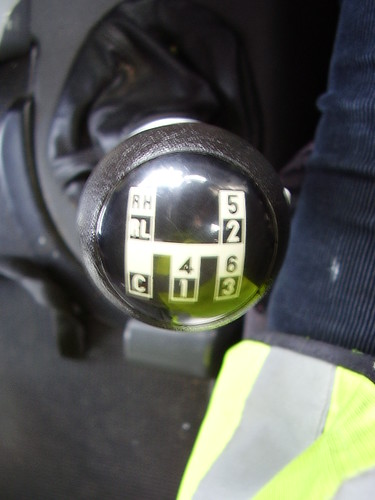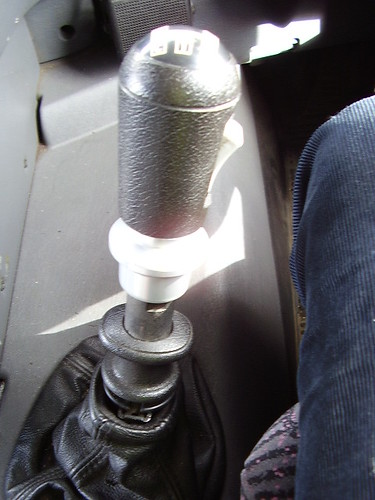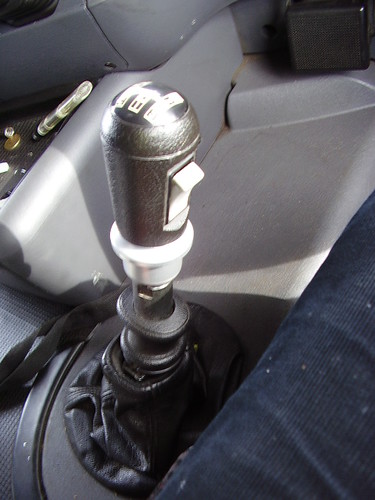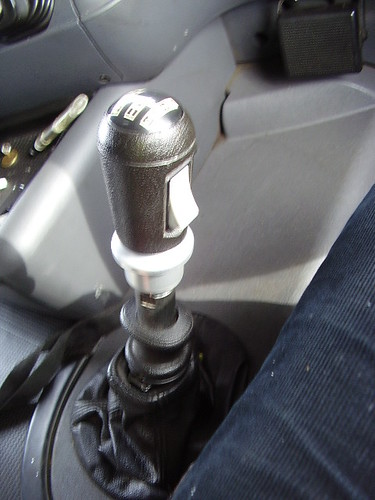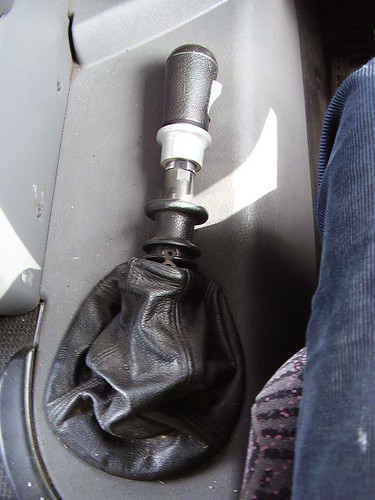An instructors explanation for the 4 over 4 gearbox…

Imagine a capital H directly on the top of, and covering another capital H with a switch on the gearstick that allows you to change from one level to another.
The gears 1 to 4 are on the lower H and gears 5 to 8 are on the upper H. Gear 1 & 5 are the same slot as are 2 & 6, 3 & 7 and 4 & 8.
Depending on circumstances, it is not always necessary to do the following as ‘block’ or ‘skip’ changing (Missing out) gears can be done.
To work through the box from 1 to 8 and 8 to 1 is as follows: -
Set switch on gearstick to low range, gear 1 is top left as you look at the H, gear 2 is bottom left, gear 3 top right, gear 4 bottom right — go through the gears just as you do for your car, gear 1, 2, 3, 4. Now it gets interesting! — Whilst still in gear 4, move switch on gearstick to high range THEN into neutral and place in the gear 1 slot that is now gear 5. Now straight back to 6 (old 2), top right is 7 (old 3) and straight back to bottom right for 8 (old 4).
Now down the gears (remembering to slow down/brake to a speed that the next gear will engage in) — 8 to 7 to 6 to 5 — range switch to low THEN neutral and into the 4 slot then 3, 2, 1.
On the down changes it will help you a lot if your foot is on the accelerator and not the brake when changing the gear as it gives you the option of “blipping the throttle” to match transmission speed with road speed if you are going a bit too fast for the gear to comfortably engage. It is also known as the “racing driver gear change” for when they want to keep high revs when going into a lower gear.
If you are having problems when changing the range from say, gear 3 to 5 or 5 to 3, then remember, you can flick the switch in readiness as it will not change the range until you put it in neutral.
An example using an empty truck from a static start and block changing up: -
Starting in neutral - Switch down - now in low, into 2nd, move off, keeping switch down select 4th and immediately put switch up - the range will not change, it is still in low - now change into 6th without touching the range switch as it is already set to go into high the moment you pass through neutral.
If the problems are due to rushing the gear change then ‘SAY HELLO’ to neutral ![]() - gear 7 to 5 - take out of 7. “HELLO NEUTRAL”, into 5
- gear 7 to 5 - take out of 7. “HELLO NEUTRAL”, into 5
The main problem with these gearboxes is NERVES - especially with males as the nerves make the arm muscles tighten and they end up forcing the gearstick through the reverse gate and trying to get crawler or reverse instead of 5th etc. This is shown by the number of minors in the gears section of the examiners sheet and if it gets to 4 then a serious is marked and is therefore a fail.
Another nerves prob is to move the range switch when changing to other gears in the same range and they are therefore now trying to get an innapropriate gear in the wrong range.
Think through each gear change, dont rush it and dont get nerves - job done!
bestbooties:
A range change is a case of going through the main gearbox twice,once in low range,then into high range,which can be switch,slap over,or collar type.
The switch or collar type is USUALLY down for low box and up for high box.
Starting off in the low box,which gear depends on whether you are loaded or not,(experience will tell you).Change as normal up to 4th gear,lift the switch or collar into high just before the next change,(the change will not take place until you go through neutral),then change from 4th low UP to first high and continue to 4th high.Changing down is exactly the reverse operation.
On the slap over type,when you “slap over” the gear lever to the left,the lever will then rest in the 3rd and 4th position.therefore you will need to push the lever over against the spring to get 1st and second as you would do on most cars.When you have changed up to 4th,to get into 5th,go to change up as you would normally,push the lever into neutral,then “slap” it over towards you,let it centre,then straight forward again and you are in 5th gear. Straight back for 6th,then forward into neutral then towards you against the spring and forward into 7th.Straight back into 8th.Changing down is the reverse sequence.
On the “Slapover"type,reverse is usually on the “Low” side,so slapping over to reverse it’s automatically in low so it’s not possible to be in"High reverse”,whereas some swith or collar type,unless they have an interlock,it may be possible to engage reverse when in high range.
On the “Splitter” type’box,However many gears are in the main 'box,you only have to go through once,but every gear is “split” or halved as you change.
The "Splitter"switch is also normally down for “Low” and up for “High”.
You would start off in whichever gear is required,depending on load and conditions,usually in “Low split”.If you wish to “Split up”,move the selector switch to “High”.Nothing will happen until you disengage the clutch.simply use the clutch to change up to “High split” .To do a “Split change”,if you are in for example 3rd gear "High"and you wish to go up to 4th “Low”,depress your switch into the “Low” position,then change up to the next gear,the “Splitter” will change down to “Low” as you go through neutral,because in effect you are only going up half a gear,it can be a quicker change.You may not need to split every gear,if you are empty or the going is easy,you may only need to use the “Splitter” on the top few gears.
Again,unless there is an inhibitor,it is possible to engage “High” reverse.
A “Range change” plus “Splitter” gearbox is a combination of the two and can take a little more time to get used to.
But hey,you will only be learning on one type at a time.It is not possible to teach someone to drive or overcome the percieved complexities of a modern transmission on a thread like this.
Half an hour on a straight piece of road should be enough to master the basics of the average modern gearbox.

Krankee:
You may have heard the terms “Splitters” and “Range Changers” but do you know what they mean and how to make best use of these features?
A “Splitter” is a feature that provides both a high and a low ratio in EVERY gear. A switch or air valve mounted on the gear lever operates it. The operation of the splitter can be pre-selected and when a ratio change is required, the simple action of dipping the clutch will enable the feature to function. Whereas a typical gear change will vary the rev counter needle the full arc of the green segment, the operation of the splitter will result in a rev change of half of that segment. Hence, it is often referred to as “Half a gear”, and effectively doubles the number of gear options available to a driver.
Any vehicle, when travelling on a flat road, will lose speed when the clutch is disengaged. This is caused by a number of factors, which include wind resistance, friction between moving parts, and the rolling resistance of the tyres. Speed losses are more pronounced for a laden truck on an uphill gradient.
A splitter gives the driver the option of compensating for these speed losses and thereby enables him to maintain the revs of the engine within the band that provides for both best fuel efficiency and maximum power output, whilst minimising strain and wear on the drive train.
Typical usage of the splitter would entail starting off in 2nd low, moving the switch to pre-select 2nd high, then dipping the clutch when the rev counter reaches the top of the green segment, thereby engaging 2nd high.
As the road speed increases, the driver then moves the switch to the low position, and when the next gear change is required, the action of depressing the clutch whilst moving the gear into 3rd, will result enable the splitter to operate and 3rd low will be selected.
The driver then repeats the sequence as the road speed continues to increase.
Conversely, on a downhill gradient, where the weight of the vehicle will cause it to gain speed, and a full gear change will quickly bring the rev counter back to the top of the green arc, the driver may choose to change a “Gear and a half”.
The sequence for this, for example, would be to start off in 3rd low, move the switch to the high position, and by changing into 4th gear, 4th high would be engaged. Then moving the switch back to the low position would afford a ‘skip’ change directly to 6th low.
Equally, the splitter can similarly be used when speed is lost on an uphill gradient and it becomes necessary to select a lower gear to maintain the power output within the most efficient rev band. In this situation the splitter is best used only on gradients of 5% or less as on anything greater than 5%, the loss speed of the vehicle whilst the clutch is depressed, will in all probability, equate to a full gear change.
RANGE CHANGERS
A “Range Changer” is simply an ‘engineered’ method of providing the driver easy access to the full range of gears fitted to the vehicle. Just imagine trying to correctly select any of eight gears that were formatted in a typical car type layout.
The Range Changer enables manufacturers to provide the driver with a gear lever that has a typical four speed H configuration and a switch to determine whether gears 1-4 or 5-8, are to be selected. Like the splitter, the Range Changer can be pre-selected, but is only activated when the gear lever passes through the neutral position.
Range Changers are commonly categorised as “4 over 4”
or “Double H”
where moving the gear lever sideways across a spring loaded pawl determines selection of high or low range.‘Skip’ changes can be accomplished with either layout.
Many modern vehicles are fitted with
both a “Splitter” AND a “Range Changer”.

An instructors explanation…
Depending on circumstances, it is not always necessary to do the following as ‘block’ or ‘skip’ changing (Missing out) gears can be done.
Going up and down ALL the 16 gears - this might get boring ![]()
Starting in 1st with splitter switch set to low = 1st low
splitter switch up and dip clutch = 1st high
splitter switch down and put into 2nd = 2nd low
splitter swich up and dip clutch = 2nd high
splitter switch down and put into 3rd = 3rd low
splitter swich up and dip clutch = 3rd high
splitter switch down and put into 4th = 4th low
splitter swich up and dip clutch = 4th high
NOW THE FUN BIT…
spltter switch down, range change switch up (or if ‘slapbox’ - slap right) and into 5th gear = 5th low
splitter swich up and dip clutch = 5th high
splitter switch down and put into 6th = 6th low
splitter swich up and dip clutch = 6th high
splitter switch down and put into 7th = 7th low
splitter swich up and dip clutch = 7th high
splitter switch down and put into 8th = 8th low
splitter swich up and dip clutch = 8th high
And now, coming down the gears starting in 8th high
splitter switch down and dip clutch = 8th low
splitter swich up and put into 7th = 7th high
splitter switch down and dip clutch = 7th low
splitter swich up and put into 6th = 6th high
splitter switch down and dip clutch = 6th low
splitter swich up and put into 5th = 5th high
splitter switch down and dip clutch = 5th low
NOW THE FUN BIT AGAIN ![]()
splitter switch up and range change switch down (or if ‘slapbox’ - slap left) and into gear 4 = 4th high
splitter switch down and dip clutch = 4th low
splitter swich up and put into 3rd = 3rd high
splitter switch down and dip clutch = 3rd low
splitter swich up and put into 2nd = 2nd high
splitter switch down and dip clutch = 2nd low
splitter swich up and put into 1st = 1st high
splitter switch down and dip clutch = 1st low
From an Instructors viewpoint…
Tockwith Training:
Without doubt introducing the upgraded vehicle requirements for driving tests has made it harder to pass the test.
Our company held on to two rusty old trucks for a few years when we really wished we could have used the newer (range change) trucks often sat in the yard doing nothing but these old ones had ‘car like’ gearboxes and thus easier to drive for novices and had a better pass rate with hard to teach drivers!
Of course some individuals can handle a range change with only a few wise words and never make it look hard work. However most other people can take 2 or 3 days to get used to it, this all costs money and we now do far less 4 day courses than we used to. So Our pass rate hasn’t changed much but its more expensive now.
Common mistakes/failures include:
Forgetting to select low range when setting off and thus trying to move away in either 7th or 8th and possibly holding up traffic. Whenever you stop choose low range when you move the lever to neutral.
Completely getting in a muddle at seemingly random times, forgetting where any gears are and what gear is required. Usually because something has leaped out the tarmac and put off the poor novice. Hopefully before the test new drivers get out of this annoying habit but the stress of the test can let it rear its ugly head again!
The gear change exercise is harder with an 8 speed, drivers may choose the wrong gear coming down the box - like 3rd instead of 1st or resume normal driving in high range by mistake. The straight 6 was easier but you could still get the wrong gear and 1st was possibly harder to find because the ratio difference between 2nd 1st was larger. On an 8 speed the difference between gears is less which makes having the correct road speed and engine rpm less of an issue (gears go in easier).
Trying to use all the gears to slow down is not seen as the modern technique, failing to come down the gears 8-6-5-4 or similar may cause test minors or a serious. Gears are for going and brakes (not gears) are for slowing! Not my opinion - the DSA’s.
Don’t bother trying to change to 5th gear on a small roundabout unless your very good, you will find yourself trying to steer with one hand on the wheel.
Setting off in high range on the hill start up or down exercise is another favourite.
I dare say I could go on.
Myself, when I learnt I just got told its a 4 over 4 gearbox here is the switch, off you go fella! I soon learnt.
Oh, and I’m not a fan of the slap over gearbox found on Renault and recycled U-Boats (mercs), they are simple but why should you do 3 lever movements instead of 2. Check out what your driving school can offer.
Example - changing from high 5 to low 4th:
Slap over -
1. Move lever to neutral
2. Slap lever to the left and let centralise
3. Pull lever back for 4th gear.
Range Change -
1. Flick switch as you put lever in neutral
2. Select 4th gear (right and back)
_________________
DSA Registered Instructor
RTITB Accredited Instructor
Now a few other bits that may be of use to you…
macplaxton:
3 over 3 range change with splitter [/b]The layout:
The range change aluminium collar: -
Shown in low range
slid up to high range
Splitter switch in low
Splitter switch in high
Lower black collar allows lever to fold:
